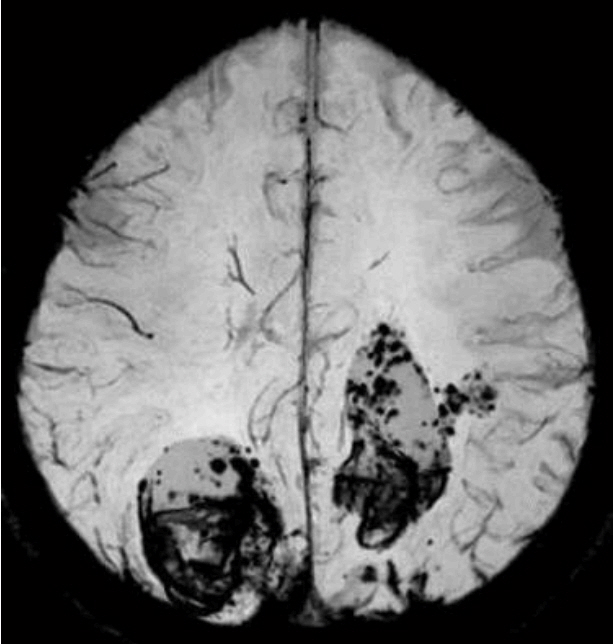J Neurocrit Care.
2017 Dec;10(2):140-142. 10.18700/jnc.170028.
Massive Extra-Ischemic Hemorrhage after Intravenous Thrombolysis in a Patient with Malignancy
- Affiliations
-
- 1Department of Neurology, Jeju National University School of Medicine, Jeju, Korea. oh.junghwan77@gmail.com
- KMID: 2405773
- DOI: http://doi.org/10.18700/jnc.170028
Abstract
- No abstract available.
MeSH Terms
Figure
Reference
-
1. Balami JS, Sutherland BA, Buchan AM. Complications associated with recombinant tissue plasminogen activator therapy for acute ischaemic stroke. CNS Neurol Disord Drug Targets. 2013; 12:155–69.
Article2. National Institute of Neurological Disorders and Stroke rt-PA Stroke Study Group. Tissue plasminogen activator for acute ischemic stroke. N Engl J Med. 1995; 333:1581–7.3. Trouillas P, von Kummer R. Classification and pathogenesis of cerebral hemorrhages after thrombolysis in ischemic stroke. Stroke. 2006; 37:556–61.
Article4. Bang OY, Seok JM, Kim SG, Hong JM, Kim HY, Lee J, et al. Ischemic stroke and cancer: stroke severely impacts cancer patients, while cancer increases the number of strokes. J Clin Neurol. 2011; 7:53–9.
Article5. Masrur S, Abdullah AR, Smith EE, Hidalgo R, El-Ghandour A, Rordorf G, et al. Risk of thrombolytic therapy for acute ischemic stroke in patients with current malignancy. J Stroke Cerebrovasc Dis. 2011; 20:124–30.
Article6. Murthy SB, Karanth S, Shah S, Shastri A, Rao CP, Bershad EM, et al. Thrombolysis for acute ischemic stroke in patients with cancer: a population study. Stroke. 2013; 44:3573–6.7. Dzialowski I, Hill MD, Coutts SB, Demchuk AM, Kent DM, Wunderlich O, et al. Extent of early ischemic changes on computed tomography (CT) before thrombolysis: prognostic value of the Alberta Stroke Program Early CT Score in ECASS II. Stroke. 2006; 37:973–8.8. Whiteley WN, Slot KB, Fernandes P, Sandercock P, Wardlaw J. Risk factors for intracranial hemorrhage in acute ischemic stroke patients treated with recombinant tissue plasminogen activator: a systematic review and meta-analysis of 55 studies. Stroke. 2012; 43:2904–9.9. Mazya MV, Ahmed N, Ford GA, Hobohm C, Mikulik R, Nunes AP, et al. Remote or extraischemic intracerebral hemorrhage-an uncommon complication of stroke thrombolysis: results from the safe implementation of treatments in stroke-international stroke thrombolysis register. Stroke. 2014; 45:1657–63.10. Ikeda H, Enatsu R, Yamana N, Nishimura M, Saiki M. Multiple extra-ischemic hemorrhages following intravenous thrombolysis in a patient with Trousseau syndrome: case study. Springerplus. 2015; 4:141.
Article11. Sun LM, Wu JN, Lin CL, Day JD, Liang JA, Liou LR, et al. Infective endocarditis and cancer risk: a population-based cohort study. Medicine (Baltimore). 2016; 95:e3198.12. Asaithambi G, Adil MM, Qureshi AI. Thrombolysis for ischemic stroke associated with infective endocarditis: results from the nationwide inpatient sample. Stroke. 2013; 44:2917–9.
- Full Text Links
- Actions
-
Cited
- CITED
-
- Close
- Share
- Similar articles
-
- Treatment of Acute Ischemic Stroke: Thrombolysis
- Intravenous Thrombolysis and Endovascular Thrombectomy in Acute Ischemic Stroke with Minor Symptom
- Intravenous t-PA Thrombolysis in an Acute Ischemic Stroke Patient With Takayasu's Arteritis
- Progression of Acute Ischemic Infarction after a Hemostatic Therapy for Thrombolysis-Related Intracerebral Hemorrhage
- Delayed Surgery for Aortic Dissection after Intravenous Thrombolysis in Acute Ischemic Stroke



